PROJ6003 - Project Execution: Risk Management Report - Frank Company
VerifiedAdded on 2022/09/22
|9
|1931
|25
Report
AI Summary
This report presents a comprehensive risk management analysis of the Robert L. Frank Construction Company, focusing on its coal liquefaction pilot plant project. It begins with an introduction to risk management principles, defining risks and their potential impacts. The report then provides an overview of the company, highlighting its operational context and the challenges it faces, including a declining backlog and workforce reductions. Risk identification and impact assessment are conducted, categorizing risks into operational, human resource, marketing, and managerial areas. The report includes a detailed risk register, outlining existing controls, risk assessments, and proposed treatment strategies. A risk probability and impact matrix is also presented to visualize the severity of different risks. Finally, the report discusses risk management and reporting, including response strategies for operational and managerial risks, staffing and procurement risks, and the importance of stakeholder communication and confidence-building measures. The report draws on relevant literature to support its analysis and recommendations.
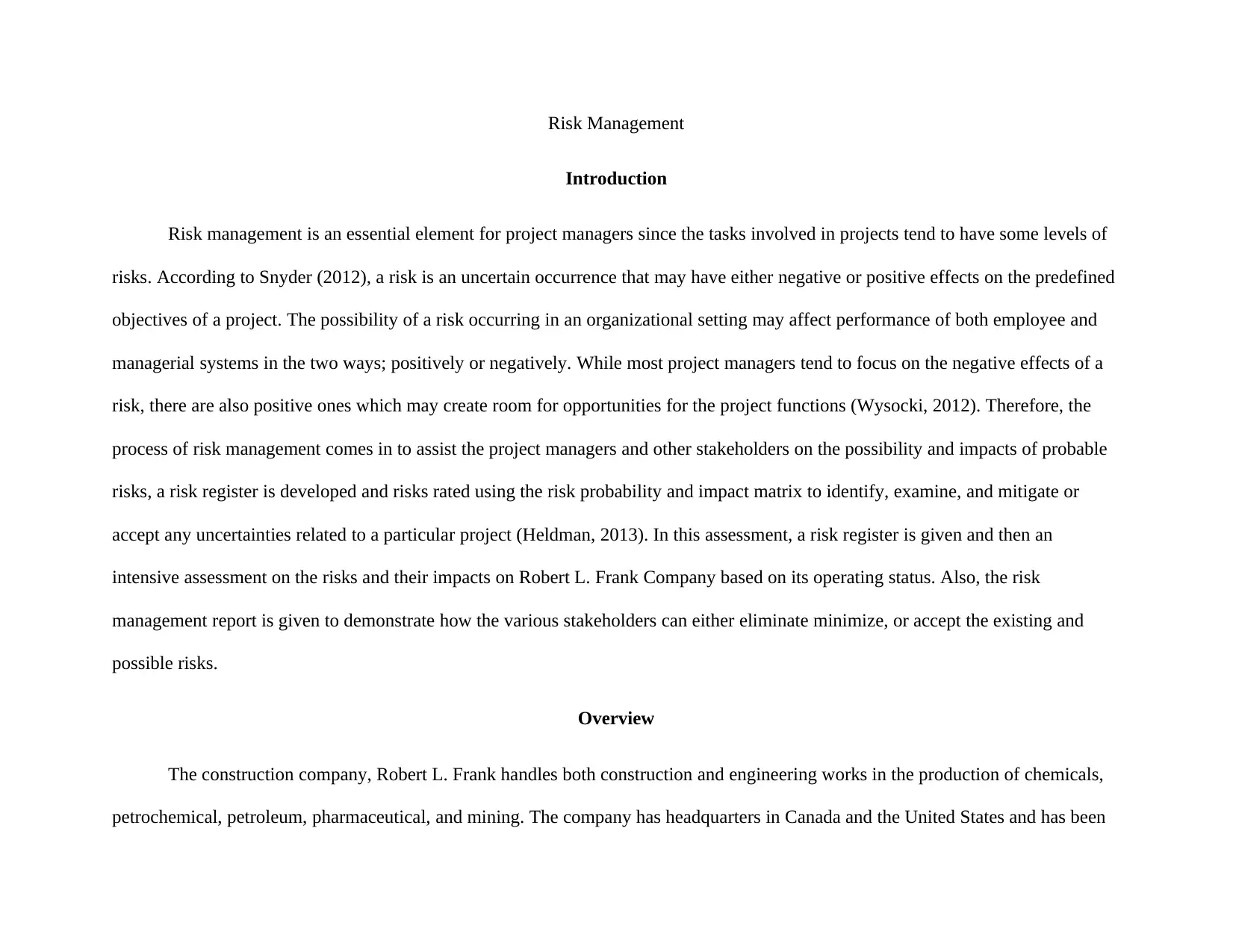
Risk Management
Introduction
Risk management is an essential element for project managers since the tasks involved in projects tend to have some levels of
risks. According to Snyder (2012), a risk is an uncertain occurrence that may have either negative or positive effects on the predefined
objectives of a project. The possibility of a risk occurring in an organizational setting may affect performance of both employee and
managerial systems in the two ways; positively or negatively. While most project managers tend to focus on the negative effects of a
risk, there are also positive ones which may create room for opportunities for the project functions (Wysocki, 2012). Therefore, the
process of risk management comes in to assist the project managers and other stakeholders on the possibility and impacts of probable
risks, a risk register is developed and risks rated using the risk probability and impact matrix to identify, examine, and mitigate or
accept any uncertainties related to a particular project (Heldman, 2013). In this assessment, a risk register is given and then an
intensive assessment on the risks and their impacts on Robert L. Frank Company based on its operating status. Also, the risk
management report is given to demonstrate how the various stakeholders can either eliminate minimize, or accept the existing and
possible risks.
Overview
The construction company, Robert L. Frank handles both construction and engineering works in the production of chemicals,
petrochemical, petroleum, pharmaceutical, and mining. The company has headquarters in Canada and the United States and has been
Introduction
Risk management is an essential element for project managers since the tasks involved in projects tend to have some levels of
risks. According to Snyder (2012), a risk is an uncertain occurrence that may have either negative or positive effects on the predefined
objectives of a project. The possibility of a risk occurring in an organizational setting may affect performance of both employee and
managerial systems in the two ways; positively or negatively. While most project managers tend to focus on the negative effects of a
risk, there are also positive ones which may create room for opportunities for the project functions (Wysocki, 2012). Therefore, the
process of risk management comes in to assist the project managers and other stakeholders on the possibility and impacts of probable
risks, a risk register is developed and risks rated using the risk probability and impact matrix to identify, examine, and mitigate or
accept any uncertainties related to a particular project (Heldman, 2013). In this assessment, a risk register is given and then an
intensive assessment on the risks and their impacts on Robert L. Frank Company based on its operating status. Also, the risk
management report is given to demonstrate how the various stakeholders can either eliminate minimize, or accept the existing and
possible risks.
Overview
The construction company, Robert L. Frank handles both construction and engineering works in the production of chemicals,
petrochemical, petroleum, pharmaceutical, and mining. The company has headquarters in Canada and the United States and has been
Paraphrase This Document
Need a fresh take? Get an instant paraphrase of this document with our AI Paraphraser
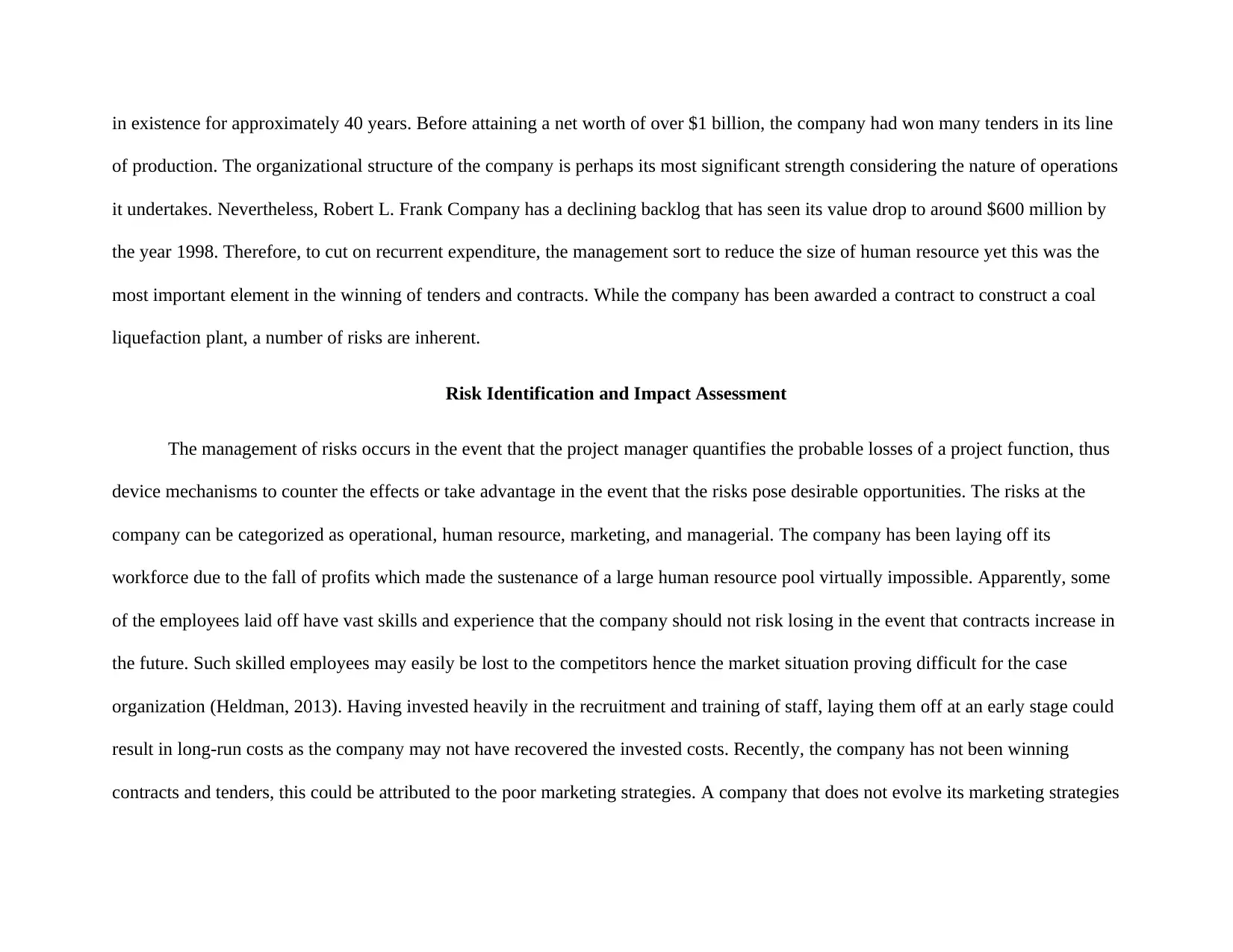
in existence for approximately 40 years. Before attaining a net worth of over $1 billion, the company had won many tenders in its line
of production. The organizational structure of the company is perhaps its most significant strength considering the nature of operations
it undertakes. Nevertheless, Robert L. Frank Company has a declining backlog that has seen its value drop to around $600 million by
the year 1998. Therefore, to cut on recurrent expenditure, the management sort to reduce the size of human resource yet this was the
most important element in the winning of tenders and contracts. While the company has been awarded a contract to construct a coal
liquefaction plant, a number of risks are inherent.
Risk Identification and Impact Assessment
The management of risks occurs in the event that the project manager quantifies the probable losses of a project function, thus
device mechanisms to counter the effects or take advantage in the event that the risks pose desirable opportunities. The risks at the
company can be categorized as operational, human resource, marketing, and managerial. The company has been laying off its
workforce due to the fall of profits which made the sustenance of a large human resource pool virtually impossible. Apparently, some
of the employees laid off have vast skills and experience that the company should not risk losing in the event that contracts increase in
the future. Such skilled employees may easily be lost to the competitors hence the market situation proving difficult for the case
organization (Heldman, 2013). Having invested heavily in the recruitment and training of staff, laying them off at an early stage could
result in long-run costs as the company may not have recovered the invested costs. Recently, the company has not been winning
contracts and tenders, this could be attributed to the poor marketing strategies. A company that does not evolve its marketing strategies
of production. The organizational structure of the company is perhaps its most significant strength considering the nature of operations
it undertakes. Nevertheless, Robert L. Frank Company has a declining backlog that has seen its value drop to around $600 million by
the year 1998. Therefore, to cut on recurrent expenditure, the management sort to reduce the size of human resource yet this was the
most important element in the winning of tenders and contracts. While the company has been awarded a contract to construct a coal
liquefaction plant, a number of risks are inherent.
Risk Identification and Impact Assessment
The management of risks occurs in the event that the project manager quantifies the probable losses of a project function, thus
device mechanisms to counter the effects or take advantage in the event that the risks pose desirable opportunities. The risks at the
company can be categorized as operational, human resource, marketing, and managerial. The company has been laying off its
workforce due to the fall of profits which made the sustenance of a large human resource pool virtually impossible. Apparently, some
of the employees laid off have vast skills and experience that the company should not risk losing in the event that contracts increase in
the future. Such skilled employees may easily be lost to the competitors hence the market situation proving difficult for the case
organization (Heldman, 2013). Having invested heavily in the recruitment and training of staff, laying them off at an early stage could
result in long-run costs as the company may not have recovered the invested costs. Recently, the company has not been winning
contracts and tenders, this could be attributed to the poor marketing strategies. A company that does not evolve its marketing strategies
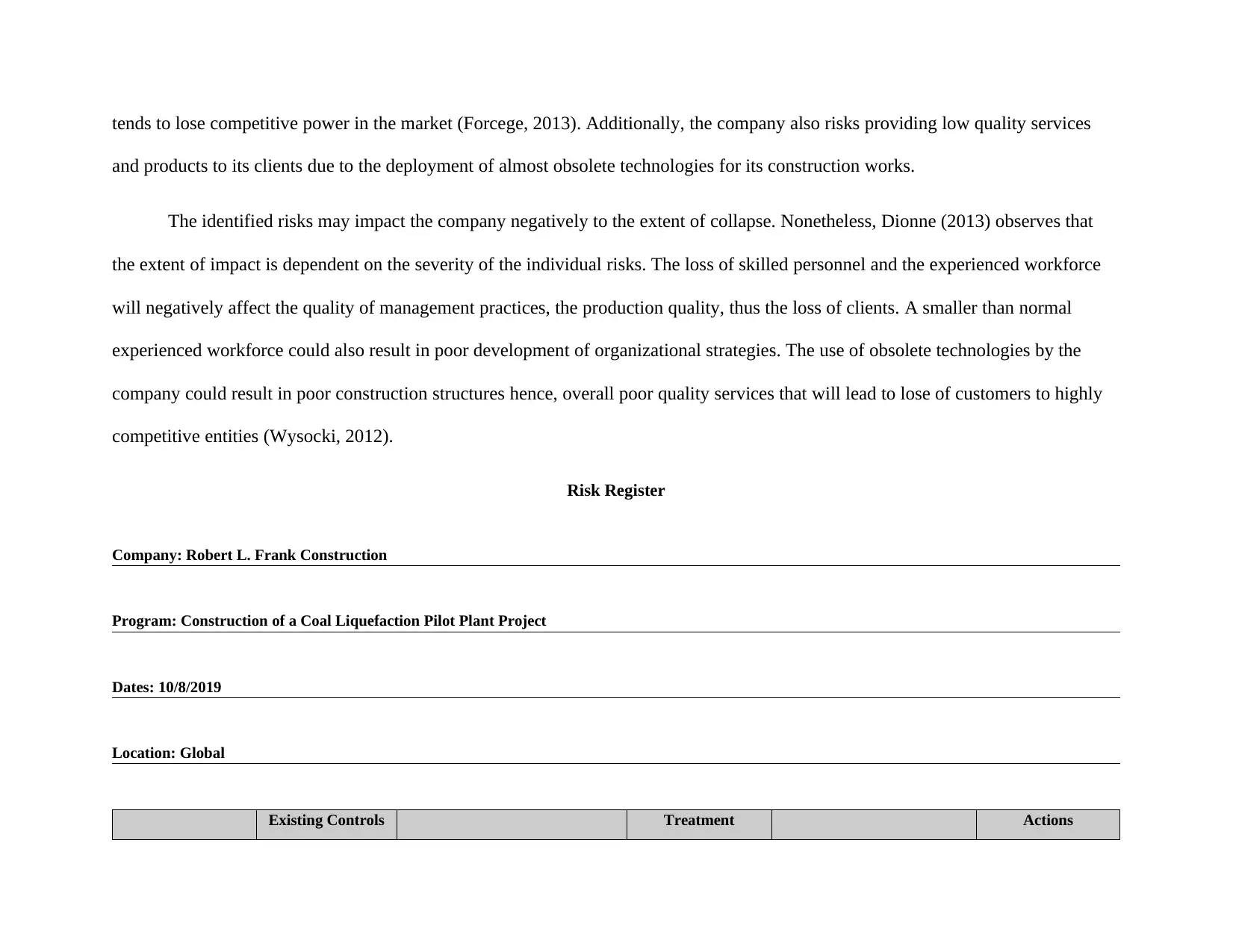
tends to lose competitive power in the market (Forcege, 2013). Additionally, the company also risks providing low quality services
and products to its clients due to the deployment of almost obsolete technologies for its construction works.
The identified risks may impact the company negatively to the extent of collapse. Nonetheless, Dionne (2013) observes that
the extent of impact is dependent on the severity of the individual risks. The loss of skilled personnel and the experienced workforce
will negatively affect the quality of management practices, the production quality, thus the loss of clients. A smaller than normal
experienced workforce could also result in poor development of organizational strategies. The use of obsolete technologies by the
company could result in poor construction structures hence, overall poor quality services that will lead to lose of customers to highly
competitive entities (Wysocki, 2012).
Risk Register
Company: Robert L. Frank Construction
Program: Construction of a Coal Liquefaction Pilot Plant Project
Dates: 10/8/2019
Location: Global
Existing Controls Treatment Actions
and products to its clients due to the deployment of almost obsolete technologies for its construction works.
The identified risks may impact the company negatively to the extent of collapse. Nonetheless, Dionne (2013) observes that
the extent of impact is dependent on the severity of the individual risks. The loss of skilled personnel and the experienced workforce
will negatively affect the quality of management practices, the production quality, thus the loss of clients. A smaller than normal
experienced workforce could also result in poor development of organizational strategies. The use of obsolete technologies by the
company could result in poor construction structures hence, overall poor quality services that will lead to lose of customers to highly
competitive entities (Wysocki, 2012).
Risk Register
Company: Robert L. Frank Construction
Program: Construction of a Coal Liquefaction Pilot Plant Project
Dates: 10/8/2019
Location: Global
Existing Controls Treatment Actions
⊘ This is a preview!⊘
Do you want full access?
Subscribe today to unlock all pages.

Trusted by 1+ million students worldwide
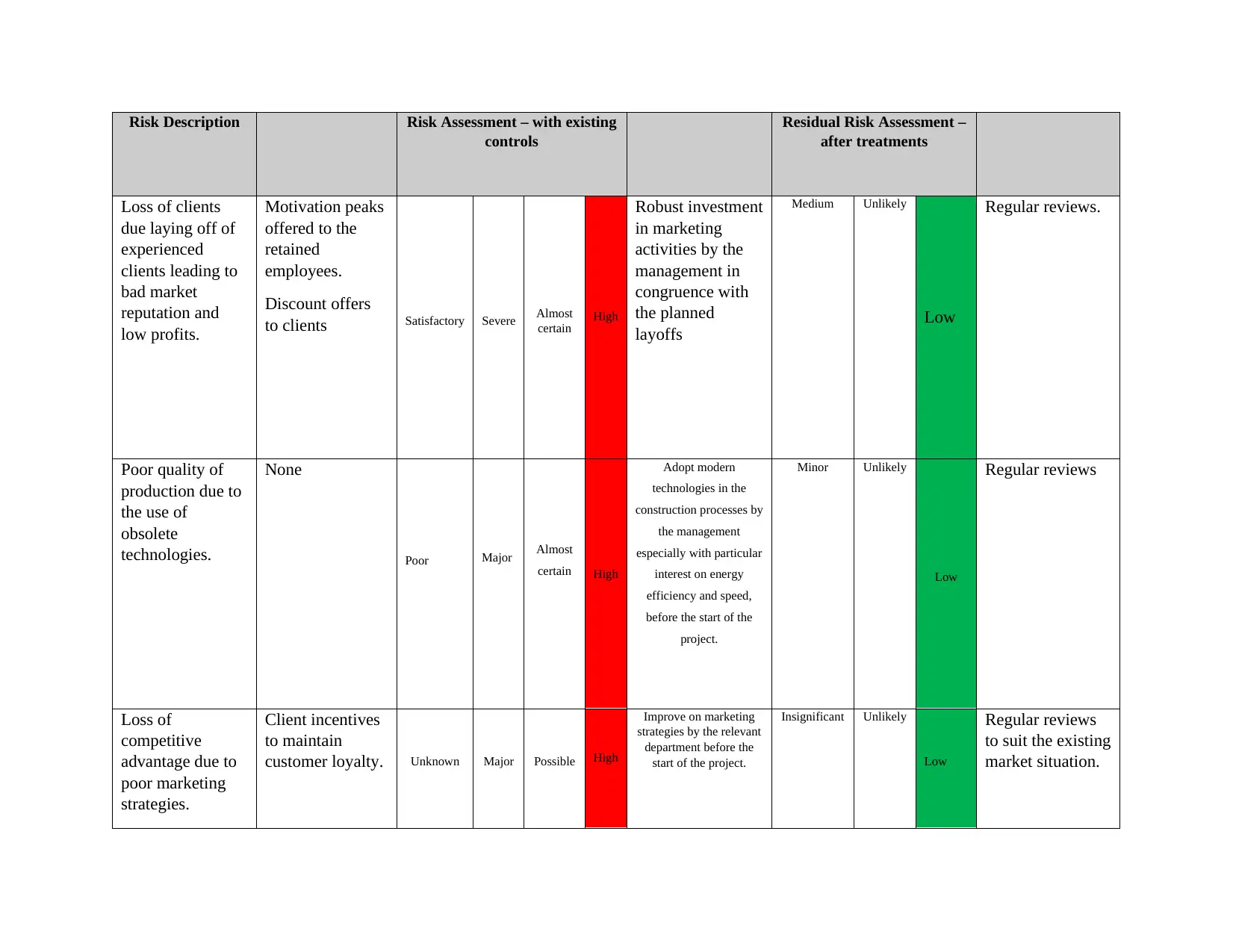
Risk Description Risk Assessment – with existing
controls
Residual Risk Assessment –
after treatments
Loss of clients
due laying off of
experienced
clients leading to
bad market
reputation and
low profits.
Motivation peaks
offered to the
retained
employees.
Discount offers
to clients Satisfactory Severe Almost
certain High
Robust investment
in marketing
activities by the
management in
congruence with
the planned
layoffs
Medium Unlikely
Low
Regular reviews.
Poor quality of
production due to
the use of
obsolete
technologies.
None
Poor Major Almost
certain High
Adopt modern
technologies in the
construction processes by
the management
especially with particular
interest on energy
efficiency and speed,
before the start of the
project.
Minor Unlikely
Low
Regular reviews
Loss of
competitive
advantage due to
poor marketing
strategies.
Client incentives
to maintain
customer loyalty. Unknown Major Possible High
Improve on marketing
strategies by the relevant
department before the
start of the project.
Insignificant Unlikely
Low
Regular reviews
to suit the existing
market situation.
controls
Residual Risk Assessment –
after treatments
Loss of clients
due laying off of
experienced
clients leading to
bad market
reputation and
low profits.
Motivation peaks
offered to the
retained
employees.
Discount offers
to clients Satisfactory Severe Almost
certain High
Robust investment
in marketing
activities by the
management in
congruence with
the planned
layoffs
Medium Unlikely
Low
Regular reviews.
Poor quality of
production due to
the use of
obsolete
technologies.
None
Poor Major Almost
certain High
Adopt modern
technologies in the
construction processes by
the management
especially with particular
interest on energy
efficiency and speed,
before the start of the
project.
Minor Unlikely
Low
Regular reviews
Loss of
competitive
advantage due to
poor marketing
strategies.
Client incentives
to maintain
customer loyalty. Unknown Major Possible High
Improve on marketing
strategies by the relevant
department before the
start of the project.
Insignificant Unlikely
Low
Regular reviews
to suit the existing
market situation.
Paraphrase This Document
Need a fresh take? Get an instant paraphrase of this document with our AI Paraphraser
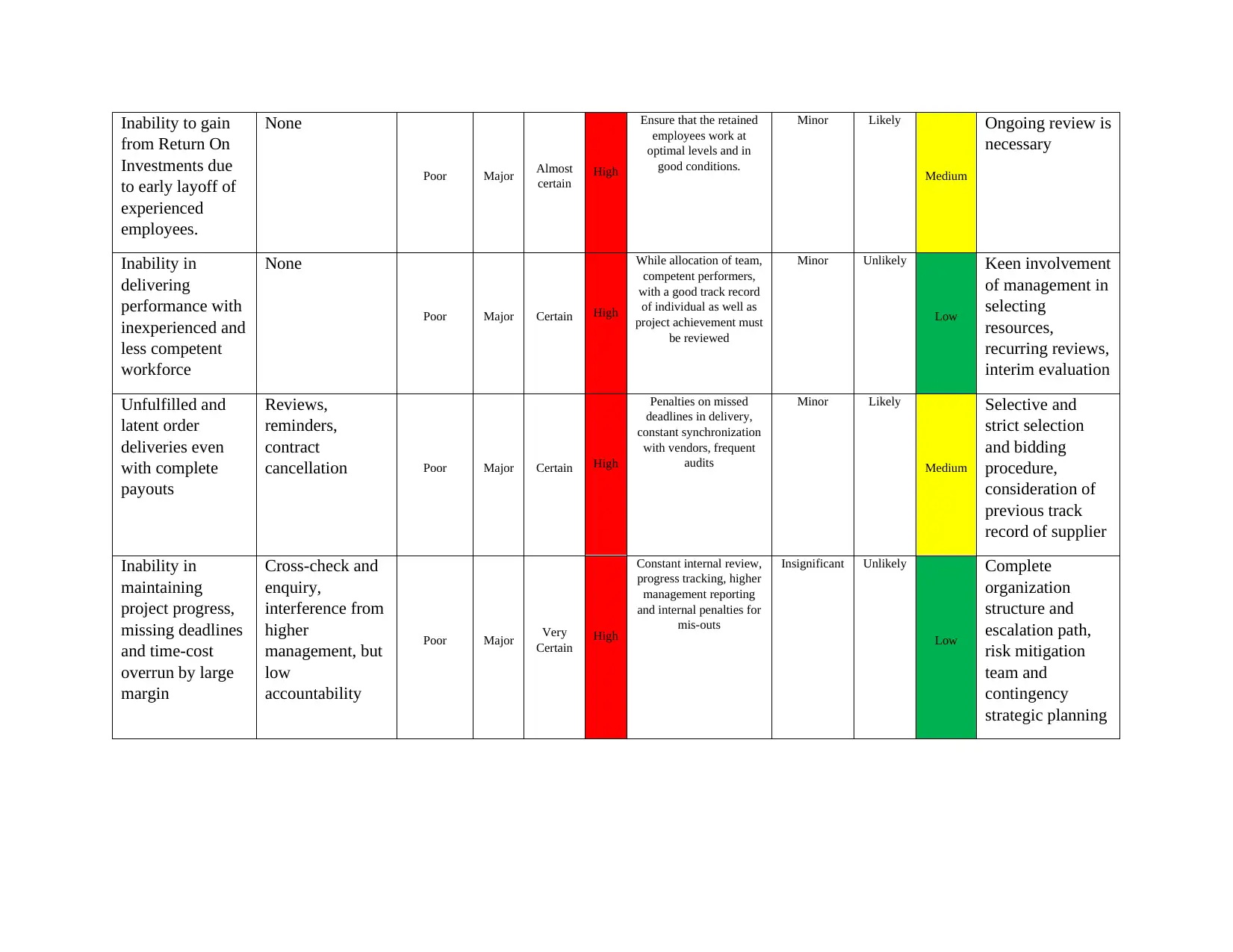
Inability to gain
from Return On
Investments due
to early layoff of
experienced
employees.
None
Poor Major Almost
certain High
Ensure that the retained
employees work at
optimal levels and in
good conditions.
Minor Likely
Medium
Ongoing review is
necessary
Inability in
delivering
performance with
inexperienced and
less competent
workforce
None
Poor Major Certain High
While allocation of team,
competent performers,
with a good track record
of individual as well as
project achievement must
be reviewed
Minor Unlikely
Low
Keen involvement
of management in
selecting
resources,
recurring reviews,
interim evaluation
Unfulfilled and
latent order
deliveries even
with complete
payouts
Reviews,
reminders,
contract
cancellation Poor Major Certain High
Penalties on missed
deadlines in delivery,
constant synchronization
with vendors, frequent
audits
Minor Likely
Medium
Selective and
strict selection
and bidding
procedure,
consideration of
previous track
record of supplier
Inability in
maintaining
project progress,
missing deadlines
and time-cost
overrun by large
margin
Cross-check and
enquiry,
interference from
higher
management, but
low
accountability
Poor Major Very
Certain High
Constant internal review,
progress tracking, higher
management reporting
and internal penalties for
mis-outs
Insignificant Unlikely
Low
Complete
organization
structure and
escalation path,
risk mitigation
team and
contingency
strategic planning
from Return On
Investments due
to early layoff of
experienced
employees.
None
Poor Major Almost
certain High
Ensure that the retained
employees work at
optimal levels and in
good conditions.
Minor Likely
Medium
Ongoing review is
necessary
Inability in
delivering
performance with
inexperienced and
less competent
workforce
None
Poor Major Certain High
While allocation of team,
competent performers,
with a good track record
of individual as well as
project achievement must
be reviewed
Minor Unlikely
Low
Keen involvement
of management in
selecting
resources,
recurring reviews,
interim evaluation
Unfulfilled and
latent order
deliveries even
with complete
payouts
Reviews,
reminders,
contract
cancellation Poor Major Certain High
Penalties on missed
deadlines in delivery,
constant synchronization
with vendors, frequent
audits
Minor Likely
Medium
Selective and
strict selection
and bidding
procedure,
consideration of
previous track
record of supplier
Inability in
maintaining
project progress,
missing deadlines
and time-cost
overrun by large
margin
Cross-check and
enquiry,
interference from
higher
management, but
low
accountability
Poor Major Very
Certain High
Constant internal review,
progress tracking, higher
management reporting
and internal penalties for
mis-outs
Insignificant Unlikely
Low
Complete
organization
structure and
escalation path,
risk mitigation
team and
contingency
strategic planning
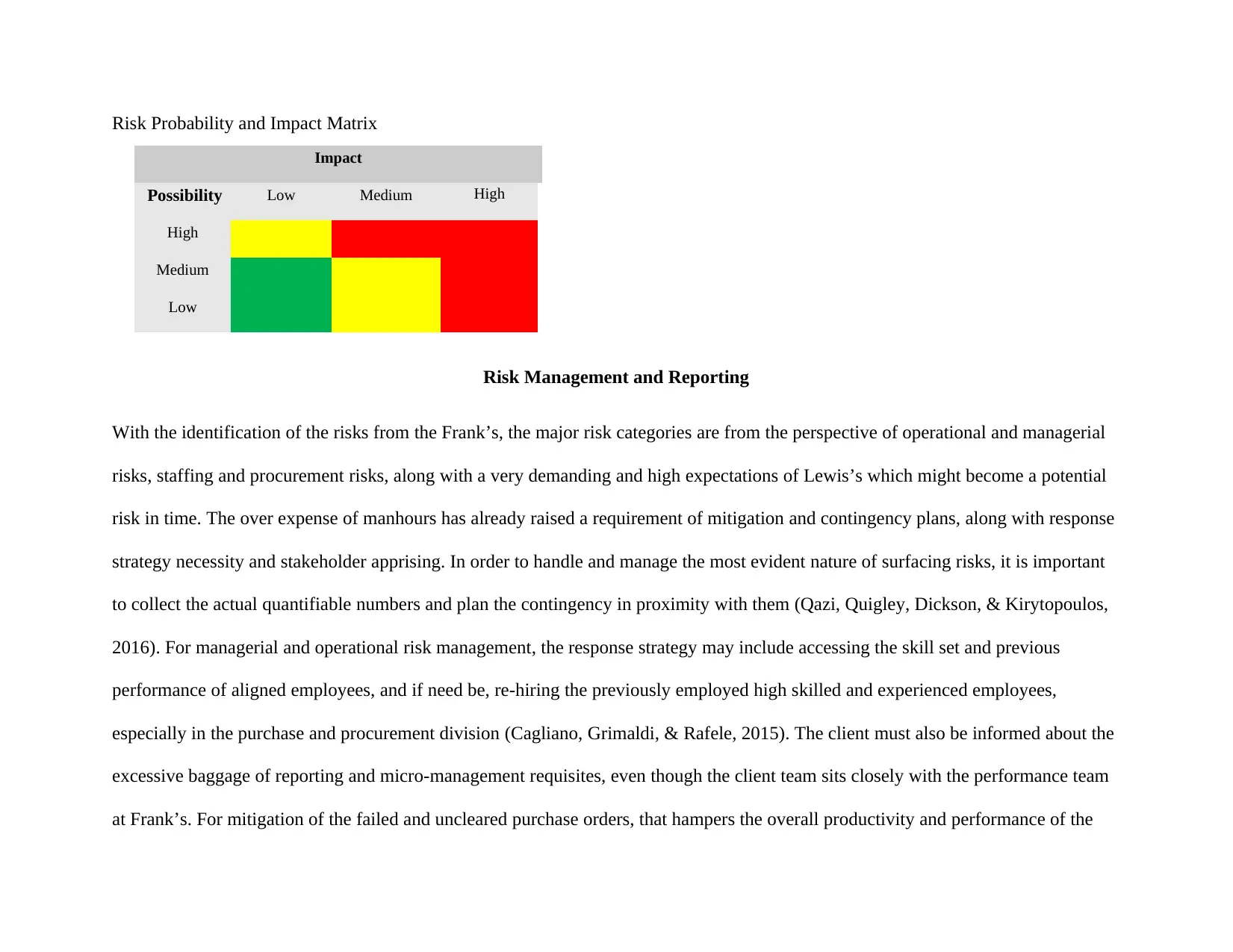
Risk Probability and Impact Matrix
Impact
Possibility Low Medium High
High
Medium
Low
Risk Management and Reporting
With the identification of the risks from the Frank’s, the major risk categories are from the perspective of operational and managerial
risks, staffing and procurement risks, along with a very demanding and high expectations of Lewis’s which might become a potential
risk in time. The over expense of manhours has already raised a requirement of mitigation and contingency plans, along with response
strategy necessity and stakeholder apprising. In order to handle and manage the most evident nature of surfacing risks, it is important
to collect the actual quantifiable numbers and plan the contingency in proximity with them (Qazi, Quigley, Dickson, & Kirytopoulos,
2016). For managerial and operational risk management, the response strategy may include accessing the skill set and previous
performance of aligned employees, and if need be, re-hiring the previously employed high skilled and experienced employees,
especially in the purchase and procurement division (Cagliano, Grimaldi, & Rafele, 2015). The client must also be informed about the
excessive baggage of reporting and micro-management requisites, even though the client team sits closely with the performance team
at Frank’s. For mitigation of the failed and uncleared purchase orders, that hampers the overall productivity and performance of the
Impact
Possibility Low Medium High
High
Medium
Low
Risk Management and Reporting
With the identification of the risks from the Frank’s, the major risk categories are from the perspective of operational and managerial
risks, staffing and procurement risks, along with a very demanding and high expectations of Lewis’s which might become a potential
risk in time. The over expense of manhours has already raised a requirement of mitigation and contingency plans, along with response
strategy necessity and stakeholder apprising. In order to handle and manage the most evident nature of surfacing risks, it is important
to collect the actual quantifiable numbers and plan the contingency in proximity with them (Qazi, Quigley, Dickson, & Kirytopoulos,
2016). For managerial and operational risk management, the response strategy may include accessing the skill set and previous
performance of aligned employees, and if need be, re-hiring the previously employed high skilled and experienced employees,
especially in the purchase and procurement division (Cagliano, Grimaldi, & Rafele, 2015). The client must also be informed about the
excessive baggage of reporting and micro-management requisites, even though the client team sits closely with the performance team
at Frank’s. For mitigation of the failed and uncleared purchase orders, that hampers the overall productivity and performance of the
⊘ This is a preview!⊘
Do you want full access?
Subscribe today to unlock all pages.

Trusted by 1+ million students worldwide
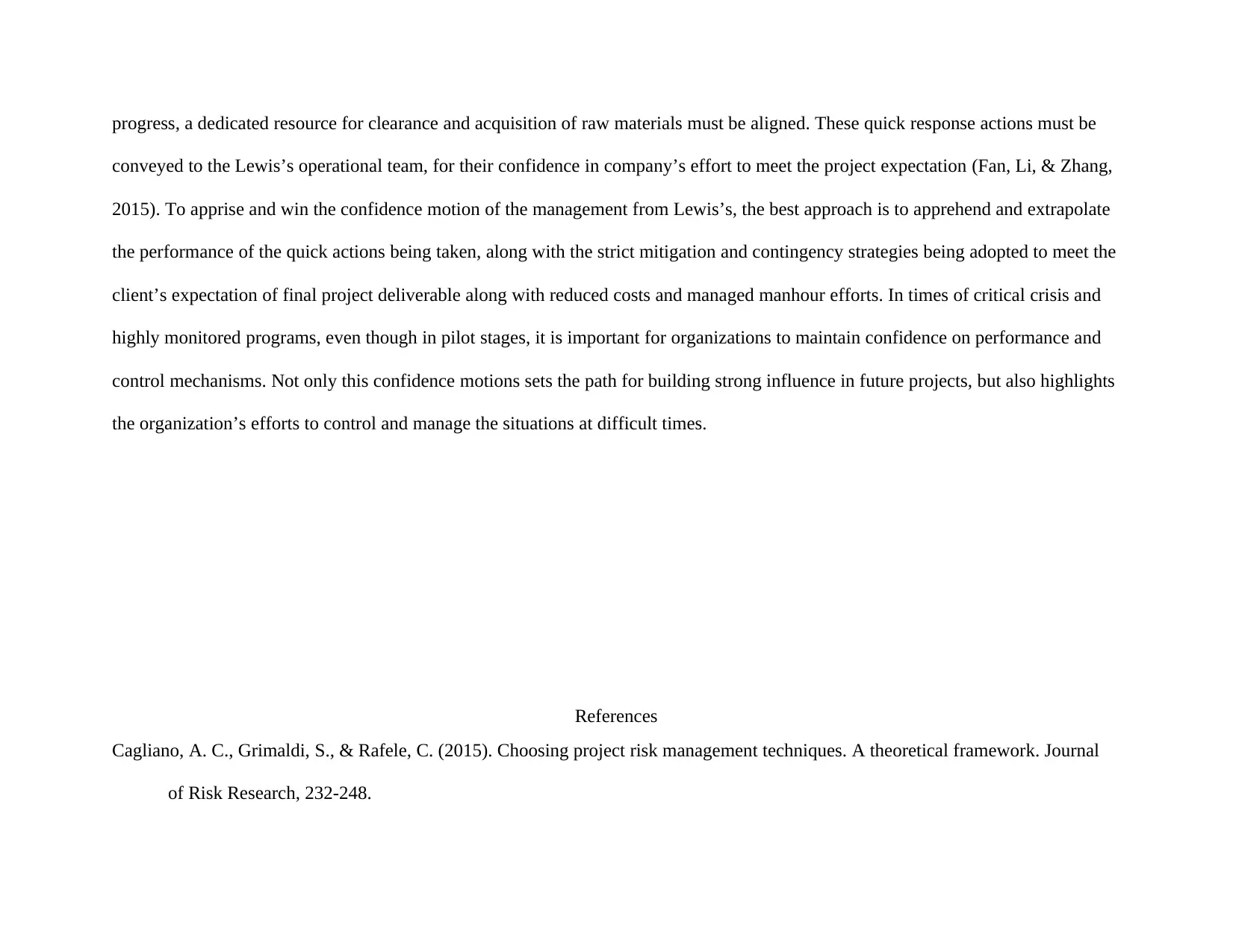
progress, a dedicated resource for clearance and acquisition of raw materials must be aligned. These quick response actions must be
conveyed to the Lewis’s operational team, for their confidence in company’s effort to meet the project expectation (Fan, Li, & Zhang,
2015). To apprise and win the confidence motion of the management from Lewis’s, the best approach is to apprehend and extrapolate
the performance of the quick actions being taken, along with the strict mitigation and contingency strategies being adopted to meet the
client’s expectation of final project deliverable along with reduced costs and managed manhour efforts. In times of critical crisis and
highly monitored programs, even though in pilot stages, it is important for organizations to maintain confidence on performance and
control mechanisms. Not only this confidence motions sets the path for building strong influence in future projects, but also highlights
the organization’s efforts to control and manage the situations at difficult times.
References
Cagliano, A. C., Grimaldi, S., & Rafele, C. (2015). Choosing project risk management techniques. A theoretical framework. Journal
of Risk Research, 232-248.
conveyed to the Lewis’s operational team, for their confidence in company’s effort to meet the project expectation (Fan, Li, & Zhang,
2015). To apprise and win the confidence motion of the management from Lewis’s, the best approach is to apprehend and extrapolate
the performance of the quick actions being taken, along with the strict mitigation and contingency strategies being adopted to meet the
client’s expectation of final project deliverable along with reduced costs and managed manhour efforts. In times of critical crisis and
highly monitored programs, even though in pilot stages, it is important for organizations to maintain confidence on performance and
control mechanisms. Not only this confidence motions sets the path for building strong influence in future projects, but also highlights
the organization’s efforts to control and manage the situations at difficult times.
References
Cagliano, A. C., Grimaldi, S., & Rafele, C. (2015). Choosing project risk management techniques. A theoretical framework. Journal
of Risk Research, 232-248.
Paraphrase This Document
Need a fresh take? Get an instant paraphrase of this document with our AI Paraphraser
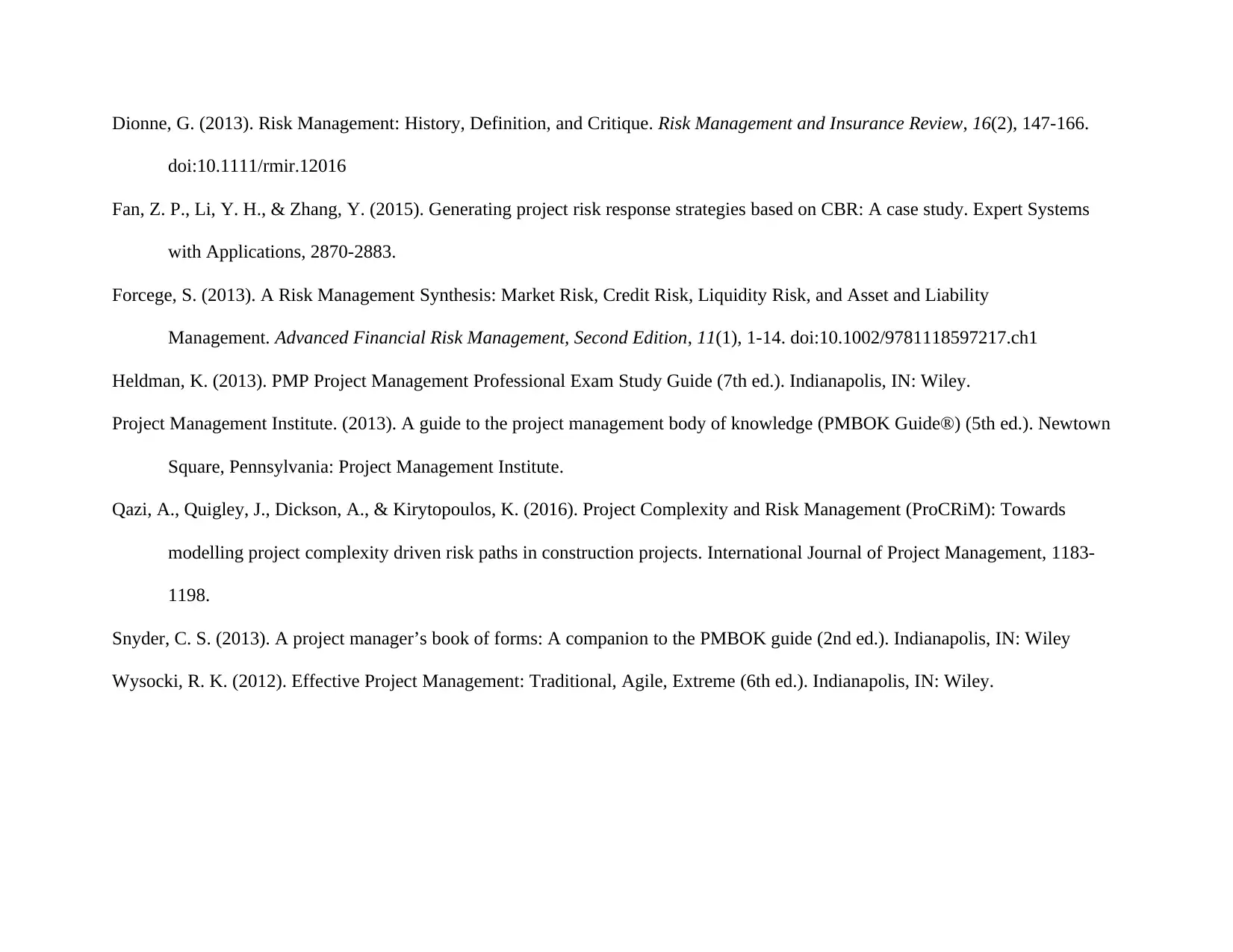
Dionne, G. (2013). Risk Management: History, Definition, and Critique. Risk Management and Insurance Review, 16(2), 147-166.
doi:10.1111/rmir.12016
Fan, Z. P., Li, Y. H., & Zhang, Y. (2015). Generating project risk response strategies based on CBR: A case study. Expert Systems
with Applications, 2870-2883.
Forcege, S. (2013). A Risk Management Synthesis: Market Risk, Credit Risk, Liquidity Risk, and Asset and Liability
Management. Advanced Financial Risk Management, Second Edition, 11(1), 1-14. doi:10.1002/9781118597217.ch1
Heldman, K. (2013). PMP Project Management Professional Exam Study Guide (7th ed.). Indianapolis, IN: Wiley.
Project Management Institute. (2013). A guide to the project management body of knowledge (PMBOK Guide®) (5th ed.). Newtown
Square, Pennsylvania: Project Management Institute.
Qazi, A., Quigley, J., Dickson, A., & Kirytopoulos, K. (2016). Project Complexity and Risk Management (ProCRiM): Towards
modelling project complexity driven risk paths in construction projects. International Journal of Project Management, 1183-
1198.
Snyder, C. S. (2013). A project manager’s book of forms: A companion to the PMBOK guide (2nd ed.). Indianapolis, IN: Wiley
Wysocki, R. K. (2012). Effective Project Management: Traditional, Agile, Extreme (6th ed.). Indianapolis, IN: Wiley.
doi:10.1111/rmir.12016
Fan, Z. P., Li, Y. H., & Zhang, Y. (2015). Generating project risk response strategies based on CBR: A case study. Expert Systems
with Applications, 2870-2883.
Forcege, S. (2013). A Risk Management Synthesis: Market Risk, Credit Risk, Liquidity Risk, and Asset and Liability
Management. Advanced Financial Risk Management, Second Edition, 11(1), 1-14. doi:10.1002/9781118597217.ch1
Heldman, K. (2013). PMP Project Management Professional Exam Study Guide (7th ed.). Indianapolis, IN: Wiley.
Project Management Institute. (2013). A guide to the project management body of knowledge (PMBOK Guide®) (5th ed.). Newtown
Square, Pennsylvania: Project Management Institute.
Qazi, A., Quigley, J., Dickson, A., & Kirytopoulos, K. (2016). Project Complexity and Risk Management (ProCRiM): Towards
modelling project complexity driven risk paths in construction projects. International Journal of Project Management, 1183-
1198.
Snyder, C. S. (2013). A project manager’s book of forms: A companion to the PMBOK guide (2nd ed.). Indianapolis, IN: Wiley
Wysocki, R. K. (2012). Effective Project Management: Traditional, Agile, Extreme (6th ed.). Indianapolis, IN: Wiley.

⊘ This is a preview!⊘
Do you want full access?
Subscribe today to unlock all pages.

Trusted by 1+ million students worldwide
1 out of 9
Related Documents
Your All-in-One AI-Powered Toolkit for Academic Success.
+13062052269
info@desklib.com
Available 24*7 on WhatsApp / Email
![[object Object]](/_next/static/media/star-bottom.7253800d.svg)
Unlock your academic potential
Copyright © 2020–2025 A2Z Services. All Rights Reserved. Developed and managed by ZUCOL.


